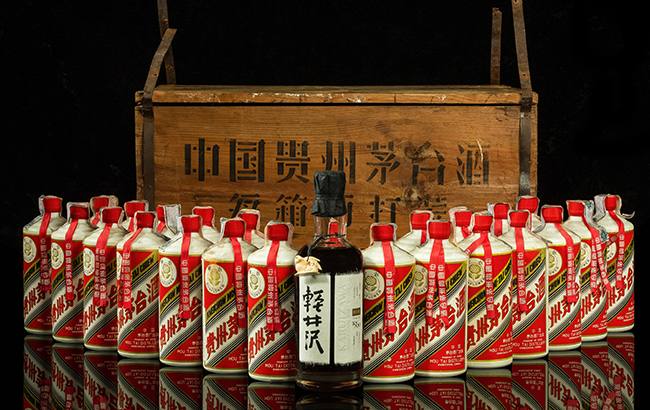Rising popularity: Asian spirits at auction
While spirits auctions have traditionally been dominated by Scotch, Asian spirits such as baijiu are making their presence felt outside of the local market, and their popularity is set to grow.

The secondary market has long been dominated by historic bottles of Scotch and whiskies from closed distilleries.
Collectors have amassed colossal collections of liquid, spanning everything from American to Japanese, which have sold for record-breaking prices.
One category that has emerged on the secondary market in the last two years is baijiu, the Chinese spirit that has remained relatively unknown outside of its country of origin.
Brand giant Moutai hit the headlines last summer when a new record was reached for the most expensive single lot sold outside of China.
The 24-strong collection of Moutai’s Sunflower 1974 fetched £1 million (US$1.4m) at a Sotheby’s auction, held in London in June 2021. It was the first Moutai lot to be presented for auction by Sotheby’s in the UK, and the most expensive Moutai to be offered by the auctioneer. It marked a significant step forward for Asian spirits and its status on the world stage.

Cultural relevance
Jonny Fowle, Sotheby’s spirits specialist, believes that the dominance of Moutai “says a lot about how popular it is domestically. In China, it’s the most culturally relevant brand, but it’s literally a foreign object to us. The brand strength is unbelievably high due to the tight allocation – it’s the equivalent of high-end Macallan and other whiskies.”
Moutai is a brand rich in historical, cultural and economic values, according to Fiona Hui, a specialist in the wine department of auction house Christie’s in Asia Pacific.
She notes how the brand is a “national spirit” and a “drink of diplomacy” that has been served to the likes of Richard Nixon, Barack Obama and Kim Jong-un.
It is often given as a gift or consumed to celebrate special occasions.
“The Western world may not be as familiar as us to Moutai,” she says. “Moutai is also described to bear an umami and soy sauce flavour, which might be more foreign to the Western drinkers’ palates, too.”
Hui says demand for Moutai is “way beyond its supply”.
She explains: “Each consumer can only buy up to two bottles from dealers, which leads to a hot secondary market. And due to the pandemic, buyers cannot travel that much, and money is diverted to domestic luxury.”
Liam Hiller, head of content at Japanese spirits retailer Dekantā, notes record-breaking auctions have led to an increased interest in the Moutai brand and the baijiu category, similar to how awards on the international stage have helped the Japanese whisky industry to boom.
He says the sector will become more important when more blind-tasting competitions include a dedicated subcategory for baijiu.
But he stresses the importance of education in the category: “For it to become popular, there needs to be more education from brands and retail. There’s still a long way to go with education. Auctions bring attention to it, but there’s a degree of uncertainty in people knowing what they’re buying.”
Derek Sandhaus, founder of Ming River baijiu, says attention from the international press benefits the category: “It’s very well known in China and throughout East Asia, but it’s a category not well understood in Europe.”
He adds that baijiu has “grown significantly in mainstream markets” such as the US and Europe.
He explains: “In the last 10 to 15 years, baijiu has gone from being virtually unknown in Western mainstream markets to something that’s appearing in hundreds, if not thousands of bars, restaurants and retail outlets.”
He says that one issue with the category is that “it isn’t being sold as a category, but more as individual brands, like Moutai or Ming River. Covid-19 probably set the development of the category back by a couple of years, but I’m still fairly optimistic that it will continue growing.”
He says the big brands spend “very little time or energy trying to sell it into mainstream markets”, due to consumers’ lack of knowledge. Fowle sees Japanese whisky and Moutai as being the most important Asian spirits on the secondary market.
“White spirits tend not to do well compared with dark spirits because you don’t get the maturation benefit with white spirits,” Fowle explains. “I don’t think you’ll see this rise in value.”
The Moutai brand is starting to become more international, he adds, with Sotheby’s moving beyond Hong Kong to offer bottles of the Chinese spirit in London, New York and Paris.
“Through the exposure we give at auction, inevitably a wave of interest follows,” Fowle says.

Surge in demand
Hui reports a surge in demand for Asian spirits at Christie’s “ever since we first introduced the sale of Japanese whisky, sake and Moutai from 2018”.
Christie’s sold its first Moutai lot, comprising 12 bottles from 1980, in September 2018 for CNY66,000 (US$10,238), three times its estimate.
Hui says: “We are offering more Asian spirits at our auctions, and we have started selling them in our Hong Kong saleroom every year since 2019; they have become a fundamental element in our sale offering.”
However, baijiu still has a long way to go to attract a global audience.
Buyers are “100% Chinese”, says Fowle, hailing from countries with a heavy Chinese population, such as Taiwan and Malaysia.
He says: “It’s the only category where we have such a specific uptake from buyers from particular regions.”
He cites Scotch as a comparison, with half of buyers hailing from the Asian market, while European and US collectors make up 25% each.
Like Fowle, Hui notes how baijiu demand is mainly led by its local market. She adds: “The demand is primarily driven by Asian buyers (approximately 75% in total), where China and Hong Kong account for the most.
“EMEA accounts for approximately 15% with the majority being UK buyers.
“In terms of age, middle-aged buyers account for the most, although we have seen growing interest from younger people – spirits are not your grandfather’s drink anymore; it is getting rather popular and trendy.”
Isabel Graham-Yool, auction director of UK auctioneer Whisky.Auction, also cites an increase in demand for Asian spirits and a rise in knowledge of these products.
“These are things that have been collected and revered for some time in Asia, like Moutai, but outside that region there’s no knowledge, so people weren’t interested in buying old and rare bottles,” she explains.
“We’ve had to train ourselves up; these are some of the most heavily faked brands in the world. We’ve had to be ruthless; if we have any doubts at Whisky.Auction then we don’t list it.”
Consumption vs investment
Graham-Yool says the products are being brought for consumption, rather than as a financial investment.
“The old bottles of Moutai are really special, this is understood and has been known by enthusiasts in China for some time, but it’s quite new for us.”
Graham-Yool says bottles of Moutai are predominantly being bought by people with an Asian background.
She also cites the UK as the second-biggest market for the brand, as well as interest in Australia, the US, Taiwan and Ireland.
While Moutai is the most dominant brand at auction, other baijius have appeared on the secondary market, including a 20-year-old Fenjiu and a bottle of Wuliangye.
With Moutai starting to set records outside of its home market, could it follow in the footsteps of the phenomenal rise of Japanese whisky at auction?
“Potentially,” answers Graham-Yool. “The thing about Japanese whisky is that it is easier because it is basically a whisky, and everyone understands the flavour profile. A genuine Japanese whisky is pretty much Scotch on steroids.
“Baijiu is a very different flavour profile; it’s like introducing someone to a particularly difficult cheese, like a really stinky cheese when they’ve never had cheese before. You have to adjust your expectations to understand it, it’s not that the cheese is weird or wrong, but you have to learn to love it.
“It would be wonderful if that happened, but it would take some time.”
Japan thrives
Japanese whisky continues to break records at auction.
In March 2020 a bottle of Karuizawa 52 Years Old Zodiac Rat Cask 51.8% ABV 1960 sold for US$435,273, setting a new record for the most valuable bottle of Japanese whisky at auction.
Bonhams Hong Kong also set an auction record for a Japanese whisky collection after Hanyu Ichiro’s Full Card Series sold for HK$11.9m (US$1.5m).
Meanwhile, lesser-known Japanese brands have cropped up on the secondary market, including Akkeshi, Akashi, and Kurayoshi, according to Hui.
Fowle notes that the Japanese whisky market is “ludicrously strong”, with prices continuing to rise.
He also highlights a Yamazaki 50-year-old, which has “never been sold in France” before, setting a record in Paris. While the Japanese whisky market is ruled by the Suntory family with highly sought-after brands such as Yamazaki and Hakushu, Fowle says brands such as Hanyu are doing well.
Graham-Yool says “all the Chichibus hit the secondary market very quickly”, while closed distilleries from Japan have also had attention, with bottles from Hanyu’s Full Card Series among the rarest.
She adds: “Five years ago I would’ve never expected to see a 12-year-old Hakushu doing very well on the market. That’s something you never see, they are very nice but available whiskies, but because they are difficult to get hold of, the prices tick them upwards.”
New guidelines in January 2021 on what defines a Japanese whisky have also resulted in more transparency in the sector.
“That will create a bit of a split, not necessarily in price, but if it’s real Japanese whisky, those will continue to rise in price and the others will probably do OK as well,” says Graham-Yool.
“As people become more knowledgeable about genuine single malts and blends from Japan, those products will continue to grow.”

